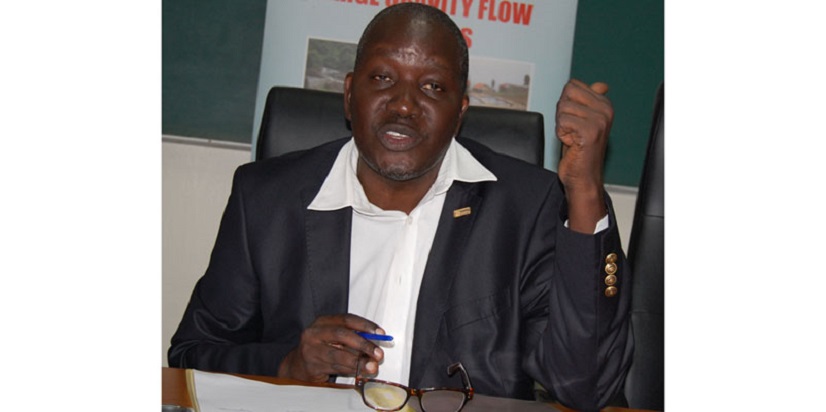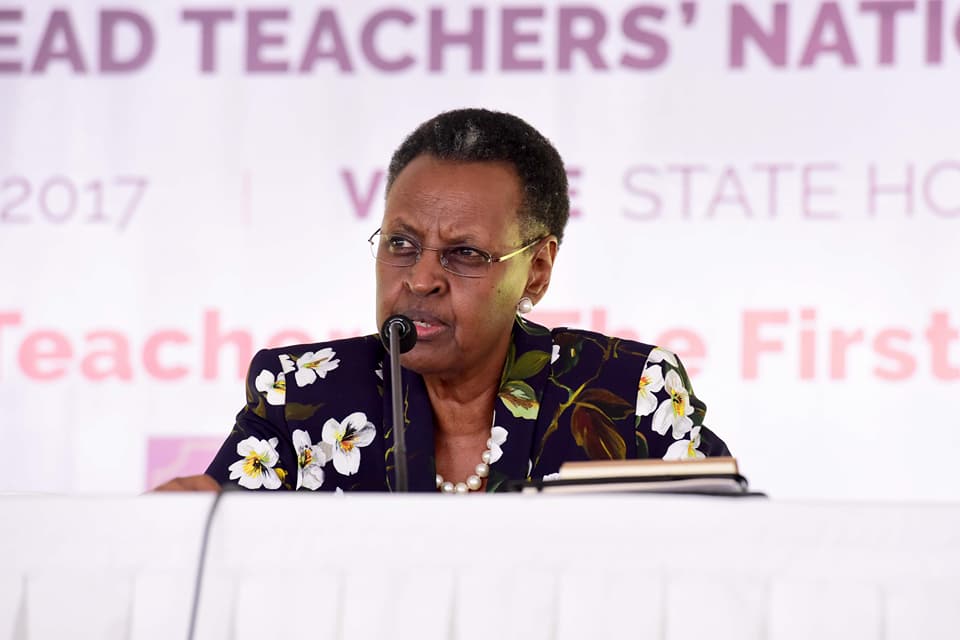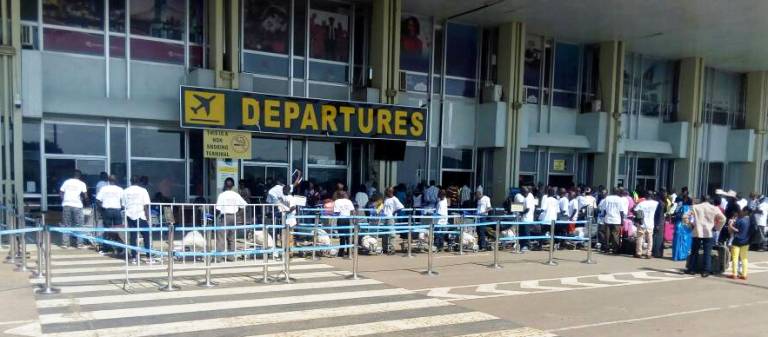Alfred Okot Okidi, the Permanent Secretary at the Ministry of Water and Environment
The Ministry of Water and Environment has reported that Uganda’s forest cover is now at 12.2% while the intact wetland cover has increased from 8.9% to 9.3%.
Alfred Okot Okidi, the Permanent Secretary at the Ministry of Water and Environment said on Friday that the ministry has committed to increase in the national forest cover from 12.4% to 15% and increase wetlands cover from 8.9% to 11.5% by 2026.
He was updating the nation on the progress made in implementing the 2021-2026 NRM Manifesto commitments.
In terms of safe and clean water, Okidi said that the government had committed to rehabilitate old rural piped water supply schemes. To this, he reported that the Ministry has rehabilitated and extended 23 piped water systems under the District Water and Sanitation Conditional Grants and that Nyabuhikye and Kikyenkye in Ibanda district; and, Shuuku and Masyoro were constructed and rehabilitated in Sheema.
“These systems serve over 159,260 persons,” the PS said.
The ministry had also committed to promote rainwater harvesting by reducing the cost of acquiring necessary equipment such as water tanks. During the period under review, Okidi said that the Ministry has constructed 1,390 communal or institutional rainwater harvesting systems (236 under the District Water and Sanitation Conditional Grant and 1,241 through NGOs’ supplementary support to government WASH programmes) serving a total of over 8,340 persons.
The government had committed to drill 5,000 environmentally-friendly and sustainable hand-powered boreholes countrywide, taking into account earth crust drainage informed by science. In deed, the ministry drilled 2,725 environmentally friendly and sustainable hand-powered boreholes countrywide, serving 817,500 persons.
In the NRM Manifesto 2021-2026, the government committed to the establishment of new bulk water systems for multipurpose use for dams in the following areas: Kyenshama Dam in Mbarara district, Geregere Dam in Agago district and Kyahi Dam in Gomba district.
Okidi said that the construction of Kyenshama Dam in Mbarara district was completed to 100%.
In Agago, Okidi said that the government completed detailed engineering designs for Geregere earth dam in Omot and Lira-palwo S/Counties in Agago District.
In Gomba, Okidi said that the implementation of Kyahi earth dam in Maddu S/County Gomba district was halted due to land related challenges.
“The Ministry is securing an alternative site for construction of a communal valley tank to serve the livestock farmers in the area,” Okidi said.
The ministry had also committed to the construction of nine communal valley tanks in Kotido, Moroto, Amudat and Nakapiripirit districts.
Okidi reported that the Ministry completed construction of Seven (07) communal Valley Tanks of Karengese in Nakapiripirit District, Napeikar, Loteteleit, Kalopedomuge and Lokipworanaron in Kotido District, Auskuyon and Katotin in Amudat District.
“This has created a total water storage of 140 million litres serving 33,300 herds of cattle throughout the year employing over 2000 people along the value chain,” Okidi said.
He added that the the Ministry has so far constructed 134 Valley Tanks on Individual farms and this has created water storage capacity of 536 million litres serving 85,000 herds of cattle throughout the year employing over 650 people along the value chain.
According to Okidi, the Ministry has so far constructed 60 communal valley tanks and this has created water storage capacity of 750 million litres serving 119,000 herds of cattle throughout the year employing over 900 people along the value chain.
Okidi said that the NRM government strategy is to ensure universal access to safe water supply, which entail (1) Improving urban water supply and sewerage coverage. He reported that the NWSC is currently serving approximately 18.1 million people, representing a water service coverage of 80%.
“The service coverage has grown by six (6) percentage points, from 74% in 2020. The sewerage coverage stands at 23%,” said Okidi.
He added that all cities, towns, trading centres, wards, cells and zones have access to get clean safe water (at least one source per village).
To this, he said that “The number of service towns under NWSC have grown by 7% (18 additional towns) from 258 towns as of June 2021, to 276 towns as of September 2024, in 95 districts.”
He added: “The number of villages served have increased by 23% (2,045) from 8,811 villages as of June 2021, to 10,856 villages as of September 2024. The village coverage is estimated at 62% of 17,601 villages under NWSC jurisdiction. During the review period, the number of villages under NWSC jurisdiction increased from 15,056 to 17,601 villages, arising mainly from the take-over of 18 additional towns. This necessitates additional resources for backbone infrastructure development and primary network expansions to meet the increased demand and effectively cover all the villages.”
On the extension of water supply to the industrial parks, Okidi said that NWSC laid a DN50mm pipe line along the boundary of Kashari Agricultural Park in Mbarara and that NWSC will work closely with UIA to ensure that connections are made to investors as and when the developments on the land commence.
In Mbale, he said that the immediate water supply system to the park had been planned by NWSC to be connected from the DN150 mm steel pipe trunk mains which supplies up to Budaka /Kabwangasi water supply services areas. NWSC will provide technical support to enable construction of a water supply system and a sewage treatment system, he said.
The Ministry of Water and Environment had also committed to promote tools that prevent and minimise pollution.
Okidi said that the ministry completed procurement of a Water Quality Research Vessel for Lake Victoria and it will contribute to improved data collection for addressing water quality pollution issues on Lake Victoria.
In terms of promoting appropriate sanitation and hygiene technologies such as bio-digestors across the country, taking into consideration vulnerable persons and those living in areas within difficult soil formations as well as transient and fishing communities, Okidi said that the Ministry through Appropriate Technology Centre has developed 4 new Appropriate Technologies and Innovations to improve Sanitation Services. These are; Water Quality Enhancement technologies i.e. 1. PEACE water filter, 2. ANOSAN Aqua Sanitizing Solution, and 3. ECO H20 Inline water filter promoted by Affordable Human Needs, blue planet Ag, and Eco Solution. 4. Volarization of waste chicken feathers for water purification.
Okidi says that a total of 1,830.3km of wetland boundary has since been demarcated with pillars and live markers.
Under National Forestry Authority (NFA),Okidi said that a cumulative total of 48,522,452 assorted seedlings were produced and supplied for community tree planting across the country from 32 nurseries in 17 management areas of Achwa, Budongo, Karamoja, Kyoga Range, Lakeshore, Muzizi, Sangobay, South west, West Nile, Lendu, Mafuga-Kabale, Mwenge, Opit Abera, South Busoga, Mbarara and Katugo. A total cumulative of 1,925.88km forest reserve boundaries were re-surveyed and marked with concrete pillars in all 17 management areas, he added.
The ministry also restored encroached and degraded section of wetlands, riverbanks and lake shores estimated at 4,942.55Km2 out of the current 9,885.1Km2.
Challenges
“Delayed approvals by the Development Partners in form of securing “No Objection” is one of the major challenges that has affected timely delivery of project outputs,” said Okidi. He added that the impact of climate adversely affects “our water supply especially the dry spells and floods which disrupt water products at our plants across the different parts of the country.”
Due to community resistance and funding constraints, he said that implementation of Kyahi Dam in Gomba District dam was set aside. Okidi also reported prolonged process of land acquisition and compensation of Project Affected Persons (PAPs) delayed commencement of some projects as one of the challenges affecting works of the ministry.
He added: “Limited Financial Resources that do not match the growing population, encroachment pressure and needs to restore and demarcate wetlands and forests and also provide alternative livelihood options to the user communities.”
He also decried increased encroachment especially from development and unsustainable Agriculture which he said have been worsened by uncoordinated government efforts, conflicting institutional mandates, policies and laws with regard to management and use of environment resources.
He, however, recommends the following as solutions to the existing challenges;
-Strengthening partnerships with the various MDAs and Development partners through strategic stakeholder engagements.
-Implementation of climate change resilient infrastructure in the various NWSC Towns, through mixed technology options and decentralized Water Supply and Sanitation systems.
-There is need to invest in research on wetland products, value addition and provide incentives for conservation.
-Harmonise institutional mandates and streamline management of forests and wetlands across all levels, hence limiting of government developments in wetlands.
-Improve environment law enforcement and governance through professional investigation and prosecution of environmental crimes.
-Increase public engagements and awareness on dangers of deforestation and encroachment of wetlands, climate disasters and opportunities for environmental restoration.





